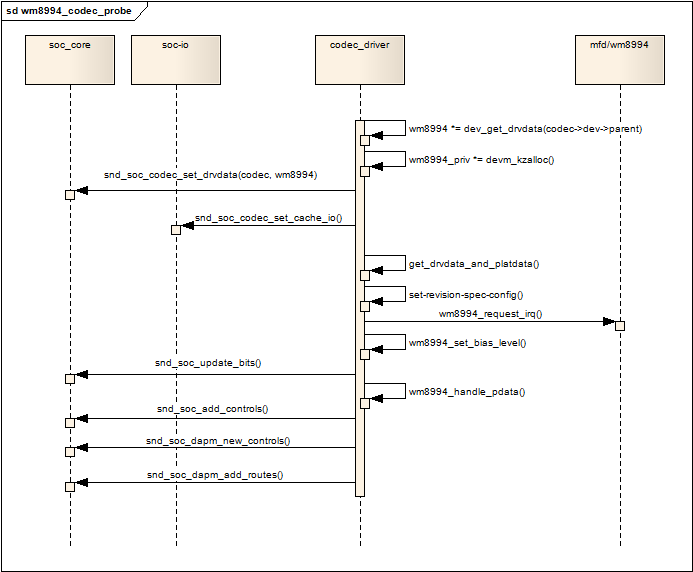1. ?Codec簡(jiǎn)介
在移動(dòng)設(shè)備中,Codec的作用可以歸結(jié)為4種,分別是:
對(duì)PCM等信號(hào)進(jìn)行D/A轉(zhuǎn)換,把數(shù)字的音頻信號(hào)轉(zhuǎn)換為模擬信號(hào)
對(duì)Mic、Linein或者其他輸入源的模擬信號(hào)進(jìn)行A/D轉(zhuǎn)換,把模擬的聲音信號(hào)轉(zhuǎn)變CPU能夠處理的數(shù)字信號(hào)
對(duì)音頻通路進(jìn)行控制,比如播放音樂,收聽調(diào)頻收音機(jī),又或者接聽電話時(shí),音頻信號(hào)在codec內(nèi)的流通路線是不一樣的
對(duì)音頻信號(hào)做出相應(yīng)的處理,例如音量控制,功率放大,EQ控制等等
ASoC對(duì)Codec的這些功能都定義好了一些列相應(yīng)的接口,以方便地對(duì)Codec進(jìn)行控制。ASoC對(duì)Codec驅(qū)動(dòng)的一個(gè)基本要求是:驅(qū)動(dòng)程序的代碼必須要做到平臺(tái)無關(guān)性,以方便同一個(gè)Codec的代碼不經(jīng)修改即可用在不同的平臺(tái)上。以下的討論基于wolfson的Codec芯片WM8994,kernel的版本3.3.x。
/*****************************************************************************************************/
聲明:本博內(nèi)容均由http://blog.csdn.net/droidphone原創(chuàng),轉(zhuǎn)載請(qǐng)注明出處,謝謝!
/*****************************************************************************************************/
2. ?ASoC中對(duì)Codec的數(shù)據(jù)抽象
描述Codec的最主要的幾個(gè)數(shù)據(jù)結(jié)構(gòu)分別是:snd_soc_codec,snd_soc_codec_driver,snd_soc_dai,snd_soc_dai_driver,其中的snd_soc_dai和snd_soc_dai_driver在ASoC的Platform驅(qū)動(dòng)中也會(huì)使用到,Platform和Codec的DAI通過snd_soc_dai_link結(jié)構(gòu),在Machine驅(qū)動(dòng)中進(jìn)行綁定連接。下面我們先看看這幾個(gè)結(jié)構(gòu)的定義,這里我只貼出我要關(guān)注的字段,詳細(xì)的定義請(qǐng)參照:/include/sound/soc.h。
snd_soc_codec:
[html]?view plain?copy
/*?SoC?Audio?Codec?device?*/??
struct?snd_soc_codec?{??
const?char?*name;??/*?Codec的名字*/??
struct?device?*dev;?/*?指向Codec設(shè)備的指針?*/??
const?struct?snd_soc_codec_driver?*driver;?/*?指向該codec的驅(qū)動(dòng)的指針?*/??
struct?snd_soc_card?*card;????/*?指向Machine驅(qū)動(dòng)的card實(shí)例?*/??
int?num_dai;?/*?該Codec數(shù)字接口的個(gè)數(shù),目前越來越多的Codec帶有多個(gè)I2S或者是PCM接口?*/??
int?(*volatile_register)(...);??/*?用于判定某一寄存器是否是volatile?*/??
int?(*readable_register)(...);??/*?用于判定某一寄存器是否可讀?*/??
int?(*writable_register)(...);??/*?用于判定某一寄存器是否可寫?*/??
/*?runtime?*/??
......??
/*?codec?IO?*/??
void?*control_data;?/*?該指針指向的結(jié)構(gòu)用于對(duì)codec的控制,通常和read,write字段聯(lián)合使用?*/??
enum?snd_soc_control_type?control_type;/*?可以是SND_SOC_SPI,SND_SOC_I2C,SND_SOC_REGMAP中的一種?*/??
unsigned?int?(*read)(struct?snd_soc_codec?*,?unsigned?int);??/*?讀取Codec寄存器的函數(shù)?*/??
int?(*write)(struct?snd_soc_codec?*,?unsigned?int,?unsigned?int);??/*?寫入Codec寄存器的函數(shù)?*/??
/*?dapm?*/??
struct?snd_soc_dapm_context?dapm;??/*?用于DAPM控件?*/??
};??
snd_soc_codec_driver:
[html]?view plain?copy
/*?codec?driver?*/??
struct?snd_soc_codec_driver?{??
/*?driver?ops?*/??
int?(*probe)(struct?snd_soc_codec?*);??/*?codec驅(qū)動(dòng)的probe函數(shù),由snd_soc_instantiate_card回調(diào)?*/??
int?(*remove)(struct?snd_soc_codec?*);????
int?(*suspend)(struct?snd_soc_codec?*);??/*?電源管理?*/??
int?(*resume)(struct?snd_soc_codec?*);??/*?電源管理?*/??
/*?Default?control?and?setup,?added?after?probe()?is?run?*/??
const?struct?snd_kcontrol_new?*controls;??/*?音頻控件指針?*/??
const?struct?snd_soc_dapm_widget?*dapm_widgets;??/*?dapm部件指針?*/??
const?struct?snd_soc_dapm_route?*dapm_routes;??/*?dapm路由指針?*/??
/*?codec?wide?operations?*/??
int?(*set_sysclk)(...);??/*?時(shí)鐘配置函數(shù)?*/??
int?(*set_pll)(...);??/*?鎖相環(huán)配置函數(shù)?*/??
/*?codec?IO?*/??
unsigned?int?(*read)(...);??/*?讀取codec寄存器函數(shù)?*/??
int?(*write)(...);??/*?寫入codec寄存器函數(shù)?*/??
int?(*volatile_register)(...);??/*?用于判定某一寄存器是否是volatile?*/??
int?(*readable_register)(...);??/*?用于判定某一寄存器是否可讀?*/??
int?(*writable_register)(...);??/*?用于判定某一寄存器是否可寫?*/??
/*?codec?bias?level?*/??
int?(*set_bias_level)(...);??/*?偏置電壓配置函數(shù)?*/??
};??
snd_soc_dai:
[html]?view plain?copy
/*??
*?Digital?Audio?Interface?runtime?data.??
*??
*?Holds?runtime?data?for?a?DAI.??
*/??
struct?snd_soc_dai?{??
const?char?*name;??/*?dai的名字?*/??
struct?device?*dev;??/*?設(shè)備指針?*/??
/*?driver?ops?*/??
struct?snd_soc_dai_driver?*driver;??/*?指向dai驅(qū)動(dòng)結(jié)構(gòu)的指針?*/??
/*?DAI?runtime?info?*/??
unsigned?int?capture_active:1;??????/*?stream?is?in?use?*/??
unsigned?int?playback_active:1;?????/*?stream?is?in?use?*/??
/*?DAI?DMA?data?*/??
void?*playback_dma_data;??/*?用于管理playback?dma?*/??
void?*capture_dma_data;??/*?用于管理capture?dma?*/??
/*?parent?platform/codec?*/??
union?{??
struct?snd_soc_platform?*platform;??/*?如果是cpu?dai,指向所綁定的平臺(tái)?*/??
struct?snd_soc_codec?*codec;??/*?如果是codec?dai指向所綁定的codec?*/??
};??
struct?snd_soc_card?*card;??/*?指向Machine驅(qū)動(dòng)中的crad實(shí)例?*/??
};??
snd_soc_dai_driver:
[html]?view plain?copy
/*??
*?Digital?Audio?Interface?Driver.??
*??
*?Describes?the?Digital?Audio?Interface?in?terms?of?its?ALSA,?DAI?and?AC97??
*?operations?and?capabilities.?Codec?and?platform?drivers?will?register?this??
*?structure?for?every?DAI?they?have.??
*??
*?This?structure?covers?the?clocking,?formating?and?ALSA?operations?for?each??
*?interface.??
*/??
struct?snd_soc_dai_driver?{??
/*?DAI?description?*/??
const?char?*name;??/*?dai驅(qū)動(dòng)名字?*/??
/*?DAI?driver?callbacks?*/??
int?(*probe)(struct?snd_soc_dai?*dai);??/*?dai驅(qū)動(dòng)的probe函數(shù),由snd_soc_instantiate_card回調(diào)?*/??
int?(*remove)(struct?snd_soc_dai?*dai);????
int?(*suspend)(struct?snd_soc_dai?*dai);??/*?電源管理?*/??
int?(*resume)(struct?snd_soc_dai?*dai);????
/*?ops?*/??
const?struct?snd_soc_dai_ops?*ops;??/*?指向本dai的snd_soc_dai_ops結(jié)構(gòu)?*/??
/*?DAI?capabilities?*/??
struct?snd_soc_pcm_stream?capture;??/*?描述capture的能力?*/??
struct?snd_soc_pcm_stream?playback;??/*?描述playback的能力?*/??
};??
snd_soc_dai_ops用于實(shí)現(xiàn)該dai的控制盒參數(shù)配置:
[html]?view plain?copy
struct?snd_soc_dai_ops?{??
/*??
*?DAI?clocking?configuration,?all?optional.??
*?Called?by?soc_card?drivers,?normally?in?their?hw_params.??
*/??
int?(*set_sysclk)(...);??
int?(*set_pll)(...);??
int?(*set_clkdiv)(...);??
/*??
*?DAI?format?configuration??
*?Called?by?soc_card?drivers,?normally?in?their?hw_params.??
*/??
int?(*set_fmt)(...);??
int?(*set_tdm_slot)(...);??
int?(*set_channel_map)(...);??
int?(*set_tristate)(...);??
/*??
*?DAI?digital?mute?-?optional.??
*?Called?by?soc-core?to?minimise?any?pops.??
*/??
int?(*digital_mute)(...);??
/*??
*?ALSA?PCM?audio?operations?-?all?optional.??
*?Called?by?soc-core?during?audio?PCM?operations.??
*/??
int?(*startup)(...);??
void?(*shutdown)(...);??
int?(*hw_params)(...);??
int?(*hw_free)(...);??
int?(*prepare)(...);??
int?(*trigger)(...);??
/*??
*?For?hardware?based?FIFO?caused?delay?reporting.??
*?Optional.??
*/??
snd_pcm_sframes_t?(*delay)(...);??
};??
3. ?Codec的注冊(cè)
因?yàn)镃odec驅(qū)動(dòng)的代碼要做到平臺(tái)無關(guān)性,要使得Machine驅(qū)動(dòng)能夠使用該Codec,Codec驅(qū)動(dòng)的首要任務(wù)就是確定snd_soc_codec和snd_soc_dai的實(shí)例,并把它們注冊(cè)到系統(tǒng)中,注冊(cè)后的codec和dai才能為Machine驅(qū)動(dòng)所用。以WM8994為例,對(duì)應(yīng)的代碼位置:/sound/soc/codecs/wm8994.c,模塊的入口函數(shù)注冊(cè)了一個(gè)platform driver:
[html]?view plain?copy
static?struct?platform_driver?wm8994_codec_driver?=?{??
.driver?=?{??
.name?=?"wm8994-codec",??
.owner?=?THIS_MODULE,??
},??
.probe?=?wm8994_probe,??
.remove?=?__devexit_p(wm8994_remove),??
};??
module_platform_driver(wm8994_codec_driver);??
有platform driver,必定會(huì)有相應(yīng)的platform device,這個(gè)platform device的來源后面再說,顯然,platform driver注冊(cè)后,probe回調(diào)將會(huì)被調(diào)用,這里是wm8994_probe函數(shù):
[html]?view plain?copy
static?int?__devinit?wm8994_probe(struct?platform_device?*pdev)??
{??
return?snd_soc_register_codec(&pdev->dev,?&soc_codec_dev_wm8994,??
wm8994_dai,?ARRAY_SIZE(wm8994_dai));??
}??
其中,soc_codec_dev_wm8994和wm8994_dai的定義如下(代碼中定義了3個(gè)dai,這里只列出第一個(gè)):
[html]?view plain?copy
static?struct?snd_soc_codec_driver?soc_codec_dev_wm8994?=?{??
.probe?=????wm8994_codec_probe,??
.remove?=???wm8994_codec_remove,??
.suspend?=??wm8994_suspend,??
.resume?=???wm8994_resume,??
.set_bias_level?=?wm8994_set_bias_level,??
.reg_cache_size?=?WM8994_MAX_REGISTER,??
.volatile_register?=?wm8994_soc_volatile,??
};??
[html]?view plain?copy
static?struct?snd_soc_dai_driver?wm8994_dai[]?=?{??
{??
.name?=?"wm8994-aif1",??
.id?=?1,??
.playback?=?{??
.stream_name?=?"AIF1?Playback",??
.channels_min?=?1,??
.channels_max?=?2,??
.rates?=?WM8994_RATES,??
.formats?=?WM8994_FORMATS,??
},??
.capture?=?{??
.stream_name?=?"AIF1?Capture",??
.channels_min?=?1,??
.channels_max?=?2,??
.rates?=?WM8994_RATES,??
.formats?=?WM8994_FORMATS,??
},??
.ops?=?&wm8994_aif1_dai_ops,??
},??
......??
}??
可見,Codec驅(qū)動(dòng)的第一個(gè)步驟就是定義snd_soc_codec_driver和snd_soc_dai_driver的實(shí)例,然后調(diào)用snd_soc_register_codec函數(shù)對(duì)Codec進(jìn)行注冊(cè)。進(jìn)入snd_soc_register_codec函數(shù)看看:
首先,它申請(qǐng)了一個(gè)snd_soc_codec結(jié)構(gòu)的實(shí)例:
[html]?view plain?copy
codec?=?kzalloc(sizeof(struct?snd_soc_codec),?GFP_KERNEL);??
確定codec的名字,這個(gè)名字很重要,Machine驅(qū)動(dòng)定義的snd_soc_dai_link中會(huì)指定每個(gè)link的codec和dai的名字,進(jìn)行匹配綁定時(shí)就是通過和這里的名字比較,從而找到該Codec的!
[html]?view plain?copy
/*?create?CODEC?component?name?*/??
codec->name?=?fmt_single_name(dev,?&codec->id);??
然后初始化它的各個(gè)字段,多數(shù)字段的值來自上面定義的snd_soc_codec_driver的實(shí)例soc_codec_dev_wm8994:
[html]?view plain?copy
codec->write?=?codec_drv->write;??
codec->read?=?codec_drv->read;??
codec->volatile_register?=?codec_drv->volatile_register;??
codec->readable_register?=?codec_drv->readable_register;??
codec->writable_register?=?codec_drv->writable_register;??
codec->dapm.bias_level?=?SND_SOC_BIAS_OFF;??
codec->dapm.dev?=?dev;??
codec->dapm.codec?=?codec;??
codec->dapm.seq_notifier?=?codec_drv->seq_notifier;??
codec->dapm.stream_event?=?codec_drv->stream_event;??
codec->dev?=?dev;??
codec->driver?=?codec_drv;??
codec->num_dai?=?num_dai;??
在做了一些寄存器緩存的初始化和配置工作后,通過snd_soc_register_dais函數(shù)對(duì)本Codec的dai進(jìn)行注冊(cè):
[html]?view plain?copy
/*?register?any?DAIs?*/??
if?(num_dai)?{??
ret?=?snd_soc_register_dais(dev,?dai_drv,?num_dai);??
if?(ret?
goto?fail;??
}??
最后,它把codec實(shí)例鏈接到全局鏈表codec_list中,并且調(diào)用snd_soc_instantiate_cards是函數(shù)觸發(fā)Machine驅(qū)動(dòng)進(jìn)行一次匹配綁定操作:
[html]?view plain?copy
list_add(&codec->list,?&codec_list);??
snd_soc_instantiate_cards();??
上面的snd_soc_register_dais函數(shù)其實(shí)也是和snd_soc_register_codec類似,顯示為每個(gè)snd_soc_dai實(shí)例分配內(nèi)存,確定dai的名字,用snd_soc_dai_driver實(shí)例的字段對(duì)它進(jìn)行必要初始化,最后把該dai鏈接到全局鏈表dai_list中,和Codec一樣,最后也會(huì)調(diào)用snd_soc_instantiate_cards函數(shù)觸發(fā)一次匹配綁定的操作。

圖3.1 dai的注冊(cè)
關(guān)于snd_soc_instantiate_cards函數(shù),請(qǐng)參閱另一篇博文:Linux音頻驅(qū)動(dòng)之六:ASoC架構(gòu)中的Machine。
4. ?mfd設(shè)備
前面已經(jīng)提到,codec驅(qū)動(dòng)把自己注冊(cè)為一個(gè)platform driver,那對(duì)應(yīng)的platform device在哪里定義?答案是在以下代碼文件中:/drivers/mfd/wm8994-core.c。
WM8994本身具備多種功能,除了codec外,它還有作為LDO和GPIO使用,這幾種功能共享一些IO和中斷資源,linux為這種設(shè)備提供了一套標(biāo)準(zhǔn)的實(shí)現(xiàn)方法:mfd設(shè)備。其基本思想是為這些功能的公共部分實(shí)現(xiàn)一個(gè)父設(shè)備,以便共享某些系統(tǒng)資源和功能,然后每個(gè)子功能實(shí)現(xiàn)為它的子設(shè)備,這樣既共享了資源和代碼,又能實(shí)現(xiàn)合理的設(shè)備層次結(jié)構(gòu),主要利用到的API就是:mfd_add_devices(),mfd_remove_devices(),mfd_cell_enable(),mfd_cell_disable(),mfd_clone_cell()。
回到wm8994-core.c中,因?yàn)閃M8994使用I2C進(jìn)行內(nèi)部寄存器的存取,它首先注冊(cè)了一個(gè)I2C驅(qū)動(dòng):
[html]?view plain?copy
static?struct?i2c_driver?wm8994_i2c_driver?=?{??
.driver?=?{??
.name?=?"wm8994",??
.owner?=?THIS_MODULE,??
.pm?=?&wm8994_pm_ops,??
.of_match_table?=?wm8994_of_match,??
},??
.probe?=?wm8994_i2c_probe,??
.remove?=?wm8994_i2c_remove,??
.id_table?=?wm8994_i2c_id,??
};??
static?int?__init?wm8994_i2c_init(void)??
{??
int?ret;??
ret?=?i2c_add_driver(&wm8994_i2c_driver);??
if?(ret?!=?0)??
pr_err("Failed?to?register?wm8994?I2C?driver:?%d ",?ret);??
return?ret;??
}??
module_init(wm8994_i2c_init);??
進(jìn)入wm8994_i2c_probe()函數(shù),它先申請(qǐng)了一個(gè)wm8994結(jié)構(gòu)的變量,該變量被作為這個(gè)I2C設(shè)備的driver_data使用,上面已經(jīng)講過,codec作為它的子設(shè)備,將會(huì)取出并使用這個(gè)driver_data。接下來,本函數(shù)利用regmap_init_i2c()初始化并獲得一個(gè)regmap結(jié)構(gòu),該結(jié)構(gòu)主要用于后續(xù)基于regmap機(jī)制的寄存器I/O,關(guān)于regmap我們留在后面再講。最后,通過wm8994_device_init()來添加mfd子設(shè)備:
[html]?view plain?copy
static?int?wm8994_i2c_probe(struct?i2c_client?*i2c,??
const?struct?i2c_device_id?*id)??
{??
struct?wm8994?*wm8994;??
int?ret;??
wm8994?=?devm_kzalloc(&i2c->dev,?sizeof(struct?wm8994),?GFP_KERNEL);??
i2c_set_clientdata(i2c,?wm8994);??
wm8994->dev?=?&i2c->dev;??
wm8994->irq?=?i2c->irq;??
wm8994->type?=?id->driver_data;??
wm8994->regmap?=?regmap_init_i2c(i2c,?&wm8994_base_regmap_config);??
return?wm8994_device_init(wm8994,?i2c->irq);??
}??
繼續(xù)進(jìn)入wm8994_device_init()函數(shù),它首先為兩個(gè)LDO添加mfd子設(shè)備:
[html]?view plain?copy
/*?Add?the?on-chip?regulators?first?for?bootstrapping?*/??
ret?=?mfd_add_devices(wm8994->dev,?-1,??
wm8994_regulator_devs,??
ARRAY_SIZE(wm8994_regulator_devs),??
NULL,?0);??
因?yàn)閃M1811,WM8994,WM8958三個(gè)芯片功能類似,因此這三個(gè)芯片都使用了WM8994的代碼,所以wm8994_device_init()接下來根據(jù)不同的芯片型號(hào)做了一些初始化動(dòng)作,這部分的代碼就不貼了。接著,從platform_data中獲得部分配置信息:
[html]?view plain?copy
if?(pdata)?{??
wm8994->irq_base?=?pdata->irq_base;??
wm8994->gpio_base?=?pdata->gpio_base;??
/*?GPIO?configuration?is?only?applied?if?it's?non-zero?*/??
......??
}??
最后,初始化irq,然后添加codec子設(shè)備和gpio子設(shè)備:
[html]?view plain?copy
wm8994_irq_init(wm8994);??
ret?=?mfd_add_devices(wm8994->dev,?-1,??
wm8994_devs,?ARRAY_SIZE(wm8994_devs),??
NULL,?0);??
經(jīng)過以上這些處理后,作為父設(shè)備的I2C設(shè)備已經(jīng)準(zhǔn)備就緒,它的下面掛著4個(gè)子設(shè)備:ldo-0,ldo-1,codec,gpio。其中,codec子設(shè)備的加入,它將會(huì)和前面所講codec的platform driver匹配,觸發(fā)probe回調(diào)完成下面所說的codec驅(qū)動(dòng)的初始化工作。
5. ?Codec初始化
Machine驅(qū)動(dòng)的初始化,codec和dai的注冊(cè),都會(huì)調(diào)用snd_soc_instantiate_cards()進(jìn)行一次聲卡和codec,dai,platform的匹配綁定過程,這里所說的綁定,正如Machine驅(qū)動(dòng)一文中所描述,就是通過3個(gè)全局鏈表,按名字進(jìn)行匹配,把匹配的codec,dai和platform實(shí)例賦值給聲卡每對(duì)dai的snd_soc_pcm_runtime變量中。一旦綁定成功,將會(huì)使得codec和dai驅(qū)動(dòng)的probe回調(diào)被調(diào)用,codec的初始化工作就在該回調(diào)中完成。對(duì)于WM8994,該回調(diào)就是wm8994_codec_probe函數(shù):

圖5.1 ?wm8994_codec_probe
取出父設(shè)備的driver_data,其實(shí)就是上一節(jié)的wm8994結(jié)構(gòu)變量,取出其中的regmap字段,復(fù)制到codec的control_data字段中;
申請(qǐng)一個(gè)wm8994_priv私有數(shù)據(jù)結(jié)構(gòu),并把它設(shè)為codec設(shè)備的driver_data;
通過snd_soc_codec_set_cache_io初始化regmap io,完成這一步后,就可以使用API:snd_soc_read(),snd_soc_write()對(duì)codec的寄存器進(jìn)行讀寫了;
把父設(shè)備的driver_data(struct wm8994)和platform_data保存到私有結(jié)構(gòu)wm8994_priv中;
因?yàn)橐瑫r(shí)支持3個(gè)芯片型號(hào),這里要根據(jù)芯片的型號(hào)做一些特定的初始化工作;
申請(qǐng)必要的幾個(gè)中斷;
設(shè)置合適的偏置電平;
通過snd_soc_update_bits修改某些寄存器;
根據(jù)父設(shè)備的platform_data,完成特定于平臺(tái)的初始化配置;
添加必要的control,dapm部件進(jìn)而dapm路由信息;
至此,codec驅(qū)動(dòng)的初始化完成。
5. ?regmap-io
我們知道,要想對(duì)codec進(jìn)行控制,通常都是通過讀寫它的內(nèi)部寄存器完成的,讀寫的接口通常是I2C或者是SPI接口,不過每個(gè)codec芯片寄存器的比特位組成都有所不同,寄存器地址的比特位也有所不同。例如WM8753的寄存器地址是7bits,數(shù)據(jù)是9bits,WM8993的寄存器地址是8bits,數(shù)據(jù)也是16bits,而WM8994的寄存器地址是16bits,數(shù)據(jù)也是16bits。在kernel3.1版本,內(nèi)核引入了一套regmap機(jī)制和相關(guān)的API,這樣就可以用統(tǒng)一的操作來實(shí)現(xiàn)對(duì)這些多樣的寄存器的控制。regmap使用起來也相對(duì)簡(jiǎn)單:
為codec定義一個(gè)regmap_config結(jié)構(gòu)實(shí)例,指定codec寄存器的地址和數(shù)據(jù)位等信息;
根據(jù)codec的控制總線類型,調(diào)用以下其中一個(gè)函數(shù),得到一個(gè)指向regmap結(jié)構(gòu)的指針:
struct regmap *regmap_init_i2c(struct i2c_client *i2c,?const struct regmap_config *config);
struct regmap *regmap_init_spi(struct spi_device *dev,?const struct regmap_config *config);
把獲得的regmap結(jié)構(gòu)指針賦值給codec->control_data;
調(diào)用soc-io的api:snd_soc_codec_set_cache_io使得soc-io和regmap進(jìn)行關(guān)聯(lián);
完成以上步驟后,codec驅(qū)動(dòng)就可以使用諸如snd_soc_read、snd_soc_write、snd_soc_update_bits等API對(duì)codec的寄存器進(jìn)行讀寫了。
?
 電子發(fā)燒友App
電子發(fā)燒友App

































評(píng)論